
|
|
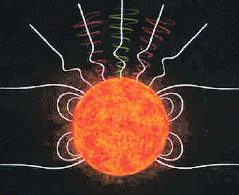
|

|
|

|
NASA Space Science News
NASA/Goddard's Solar Wind Home Page
NASA's images and movies to support this story
European Space Agency (ESA) SOHO News
(Mirrored at the
US SOHO Web Page)
NASA Press Releases and News Flashes.
The high-speed portion of the solar wind achieves its unexpectedly high velocity by "surfing" magnetic waves in the Sun's outer atmosphere to reach speeds up to 500 miles per second, according to coordinated observations by two spacecraft made during John Glenn's return to space.
For 37 years, solar scientists have been puzzled by the fact that the high-speed solar wind travels twice as fast as predicted by theory. Joint observations and theoretical analyses have discovered a surprising explanation for this mystery: magnetic waves. The observations were made using instruments aboard NASA's Spartan 201 spacecraft, deployed from the space shuttle during the STS-95 mission, and the joint European Space Agency/NASA Solar and Heliospheric Observatory (SOHO).
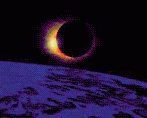 |
(4.3 Meg MPEG) SURFING THE SOLAR WIND - The outermost solar atmosphere, or corona, is normally visible only during a solar eclipse. Instruments aboard Spartan 201 and SOHO create artificial eclipses to view the accelerating solar wind of electrically charged particles. New observations of particles "surfing" on waves in the corona have shed light on an ongoing mystery of why the solar wind flows as fast as it does. (Image credit: NASA/Dana Berry, Allied Signal Max Q digital animation group) |
 |
(4.3 Meg MPEG) WIND SPIRALING AND WAVE DAMPING - Charged particles in the solar wind spiral around lines of magnetic force, and these lines oscillate back and forth to create outward-propagating waves. When the particles' spiraling frequencies match the wave frequencies, the particles can absorb the waves' energy; this spins up the particles into larger orbits, gives them an added outward boost, and damps out the waves. (Image credit: NASA/Dana Berry, Allied Signal Max Q digital animation group) |
 |
(311 K MPEG) These combined images display UV light emitted by the solar corona over one full solar rotation (27 days) in August 1996. The inner images of the solar disk were taken by the EIT instrument aboard SOHO. The outer diffuse emission was observed by the UVCS instrument aboard SOHO, which creates an "artificial eclipse" in ultraviolet light to observe the dim extended solar corona. The dark regions at the north and south poles are called "coronal holes," and they are thought to be the primary source regions of the high-speed solar wind. (Image credit: Alexander Panasyuk and Steven Cranmer, SAO) |
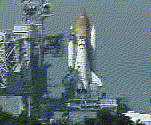 |
(1.11 Meg MPEG) Launch of the Space Shuttle Discovery on October 29, 1998, at 2:20 PM EST. The STS-95 flight was a 9-day mission during which the crew supported a variety of research payloads including deployment of the Spartan 201 solar-observing spacecraft, the Hubble Space Telescope Orbital Systems Test Platform, and investigations on space flight and the aging process. |
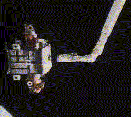 |
(1.09 Meg MPEG) Deployment of the Spartan 201 solar-observing spacecraft by the Space Shuttle's Remote Manipulator Arm on November 1, 1998. |
 |
(201 K GIF) SURFING THE SOLAR WIND: three panels from the animation sequences provided above. (Image credit: NASA/Dana Berry, Allied Signal Max Q digital animation group) |
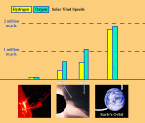 |
(67 K GIF) Bar chart showing the speeds of hydrogen and oxygen ions at four different distances from the Sun. The small speeds near the surface (left) can be probed with conventional telescopes, and the high speeds much further out in the solar system (right) can be detected directly by spacecraft. Spartan 201 and SOHO have measured speeds in the accelerating part of the solar wind and constrained possible theoretical explanations for how the wind is driven. (Image credit: Steven Cranmer, SAO) |
 |
(180 K JPG) Still frame from the Spartan 201 deployment in November 1998, during the STS-95 mission. |
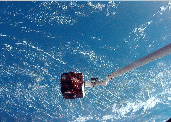 |
(180 K JPG) Still frame from the Spartan 201 deployment in November 1998, during the STS-95 mission. |
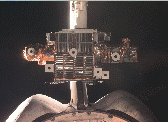 |
(180 K JPG) Still frame from the Spartan 201 deployment in November 1998, during the STS-95 mission. |
 |
(301 K GIF) The Solar and Heliospheric Observatory (SOHO) spacecraft in launch configuration prior to acoustic tests in Toulouse, France in early 1995. The Ultraviolet Coronagraph Spectrometer (UVCS) instrument is the large gold cylinder in the front. SOHO was launched on December 2, 1995 and has observed the Sun nearly continuously for more than three years. |
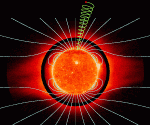 |
(108 K GIF) This combined image displays UV light emitted by the the solar corona on August 17, 1996. The solar disk image is from the EIT instrument aboard SOHO, and the extended solar corona (outside the black ring about 0.5 solar radii from the disk) is from the UVCS instrument aboard SOHO. The color in the latter image represents the total UV intensity emitted by highly ionized oxygen atoms in the corona. The blue-white rays are lines of magnetic force from a theoretical model of the magnetic field of the Sun at the minimum of solar activity (created by M. Banaszkiewicz, et al.). The surprisingly fast spiraling velocities of ions were detected in the broad spectral emission lines seen by UVCS. (Image credit: Alexander Panasyuk and Steven Cranmer, SAO) |
 |
(221 K JPG) This composite image of a total solar eclipse in 1991 was put together by Steve Albers. The black disk is the Moon, and the pink, feathery extensions are the solar corona. The corona is a region of hot, electrically charged gas streaming from the surface of the Sun. (See also other eclipse images from, for example, the High Altitude Observatory's eclipse site.) |
For additional images, see also:
Includes links to articles, books, popular Web pages, and related educational resources.
Press Release N99-076, July 8, 1999
| Donald Savage
NASA Headquarters Washington, DC (Phone: 202/358-1547)
| Bill Steigerwald
Goddard Space Flight Center Greenbelt, MD (Phone: 301/286-8955)
|
|
John L. Kohl, Leonard Strachan, Steven R. Cranmer
|
UVCS/Spartan Home Page
Spartan 201 Home Page UVCS/SOHO Home Page SOHO Home Page
|
| Brief biographies of Space Science Update panelists |
MSNBC, July 9, 1999
CNN Today, CNN, July 8, 1999 (1:00 pm)
CNN Headline News, July 8, 9, 11, 1999 (various times)
CNN Science and Technology, July 10, 1999 (1:30 pm)
Fox News, July 9, 1999
CBS News Up to the Minute, July 9, 1999 (2:00 am)
Associated Press (via Yahoo News), July 9, 1999
Reuters (via Yahoo News), July 9, 1999
Paul Harvey, Syndicated Radio, July 9, 1999 (12:55 pm)
The Houston Chronicle, July 8, 1999
The Boston Globe (page A11) July 9, 1999
Science Daily, an online science magazine, July 9, 1999
El Mundo (Spanish newspaper) July 10, 1999
The Planetary Society (Web news) July 13, 1999
Info Science (French Web site) July 16, 1999
Science News, vol. 156, page 38, July 17, 1999
Local TV News:
First News,
KCNC-TV (CBS) CH 4 Denver, July 8, 1999 (4:00 pm)
Action News,
WPVI-TV (ABC) CH 6 Philadelphia, July 8, 1999 (5:00 pm)
Eyewitness News At Five,
KPIX-TV (CBS) CH 5 San Francisco/Oakland, July 8, 1999 (5:00 pm)
News 4 New England,
WBZ-TV (CBS) CH 4 Boston, July 8, 1999 (5:00 pm)
Eyewitness News At 5,
WUSA-TV (CBS) CH 9 Washington, July 8, 1999 (5:00 pm)
KARE 11 News,
KARE-TV (NBC) CH 11 Minneapolis/St. Paul, July 8, 1999 (5:00 pm)
2 News At Five,
KTVI-TV (Fox) CH 2 St. Louis, July 8, 1999 (5:00 pm)
Eyewitness News,
WFSB-TV (CBS) CH 3 Hartford/New Haven, July 8, 1999 (5:00 pm)
S 58 News,
WDJT-TV (CBS) CH 58 Milwaukee, July 8, 1999 (5:00 pm)
Newschannel 4 At Five,
WDAF-TV (Fox) CH 4 Kansas City, July 8, 1999 (5:00 pm)
News Channel 7 At 5:00,
WSPA-TV (CBS) CH 7 Greenville, July 8, 1999 (5:00 pm)
News Channel 2 First at 5:30,
WESH-TV (NBC) CH 2 Orlando, July 8, 1999 (5:30 pm)
News 3 at 5:30,
WWMT-TV (CBS) CH 3 Grand Rapids/Kalamazoo, July 8, 1999 (5:30 pm)
Q 13 News,
KRQE-TV (CBS) CH 13 Albuquerque, July 8, 1999 (5:30 pm)
22 News,
WWLP-TV (NBC) CH 22 Springfield/Holyoke, MA, July 8, 1999 (5:30 pm)
Fox 13 6:00 News,
WTVT-TV (Fox) CH 13 Tampa/St. Pete., July 8, 1999 (6:00 pm)
Channel 69 News,
WFMZ-TV (IND) CH 69 Allentown, PA, July 8, 1999 (6:00 pm)
63 News,
WMBC-TV (IND) CH 63 New York, July 8, 1999 (8:00 pm)
Fox 13 News At Nine,
KSTU-TV (Fox) CH 13 Salt Lake City, July 8, 1999 (9:00 pm)
News At Ten,
KTLA-TV (WB) CH 5 Los Angeles, July 8, 1999 (10:00 pm)
The Ten OClock News,
WCCO-TV (CBS) CH 4 Minneapolis/St. Paul, July 8, 1999 (10:00 pm)
Your News At Ten,
Bay News 9 (IND) CH 9 Tampa/St. Pete., July 8, 1999 (10:00 pm)
KOVR 13 News Tonight,
KOVR-TV (CBS) CH 13 Sacramento, July 8, 1999 (10:00 pm)
The Ten O'Clock News,
KPTV-TV (UPN) CH 12 Portland, July 8, 1999 (10:00 pm)
K EYE Witness News At 10,
KEYE-TV (CBS) CH 42 Austin, July 8, 1999 (10:00 pm)
Eleven News,
KKTV-TV (CBS) CH 11 Colorado Springs, July 8, 1999 (10:00 pm)
News 3 at Eleven,
WWMT-TV (CBS) CH 3 Grand Rapids/Kalamazoo, July 8, 1999 (11:00 pm)
Eyewitness News 13 Late Edition,
WZZM-TV (ABC) CH 13 Grand Rapids/Kalamazoo, July 8, 1999 (11:00 pm)
Eyewitness News 21,
WHP-TV (CBS) CH 21 Harrisburg/Lancaster/York, July 8, 1999 (11:00 pm)
News 4 This Morning,
WBZ-TV (CBS) CH 4 Boston, July 9, 1999 (5:00 am)
Noticias,
GALA-TV (Ind) CH NA Los Angeles, July 9, 1999 (5:30 am)
K EYE Opener News,
KEYE-TV (CBS) CH 42 Austin, July 9, 1999 (5:30 am)
Newscenter 6 This Morning,
WKMG-TV (CBS) CH 6 Orlando, July 9, 1999 (7:00 am)
Fox 13 News At 5:00,
WHBQ-TV (Fox) CH 13 Memphis, July 9, 1999 (5:00 pm)
NBC 13 News Today,
WVTM-TV (NBC) CH 13 Birmingham, July 11, 1999 (8:00 am)
This research is supported by the National Aeronautics and Space Administration under grants NAG5-613 and NAG5-7822 to the Smithsonian Astrophysical Observatory, by Agenzia Spaziale Italiana, and by the ESA PRODEX program (Swiss contribution). The Solar and Heliospheric Observatory (SOHO) is a mission of international cooperation between ESA (the European Space Agency) and NASA.